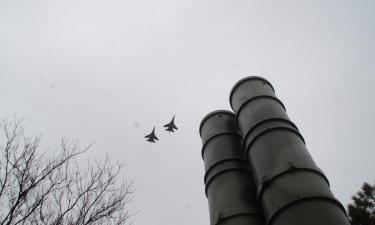Bend It Like Beckham Or Move Like Mostovoi?
Women used to be consigned the role of supporters as far as football was concerned in Russia. However, the number of female footballers is now growing fast and the first successes have been achieved. Russia finished in a respectable fifth place at the 1999 World Cup and although the team may not be a title contender in this year's tournament in the States, despite finishing second in their group, the ladies' team are certainly looking to book themselves a place at next year's Athens Olympics.
Women's football in Russia was officially born in 1992, when the first nation wide championship was held. For several years Moscow's teams set the tune. However, today the best team is, by rights, considered to be Energiya (Energy) Voronezh in central Russia, while Lada from Russia's automotive capital Togliatti (the Volga region) has won the cup for the past two seasons.
Only eight teams contest the Russian premier league, while there are nine in the first division. There are also two annual championships for under 17s and under 19s. This year saw the first Student Games in Russia involving women's football. The best Russian teams also put up a good performance in international tournaments, including the European Champions' League. Russians have made it into the quarterfinals for three consecutive years, but, unfortunately, have not progressed any further. Energiya outplayed their opponents from Italy, Hungary and Croatia in the group stage this year and again made it into the quarterfinals, where they will face Sweden's Umea IK on November 2.
Although Russia is only 11th in the FIFA ratings, experts believe the team is far stronger. The recent qualifiers for the USA only serve to prove this, as the Russians beat Italy, Spain and Iceland in their group.
Many of Russia's women footballers have won great acclaim for their skills in Europe. The most famous are forward Natalya Barbashina, who plays for Lada, and midfielder Yelena Fomina from the air force team VVS, which plays in another Volga city, Samara. Both Barbashina and Fomina have received repeated offers from leading overseas clubs, but neither of them wants to leave their teams in Russia.
While Barbashina and Fomina are experienced players, Russia also has a number of young, talented players who appear for the under-19s, which is one of the most promising sides on the continent. Specialists particularly point to VVS goalkeeper Elvira Todua, Chertanovo Moscow forward Yekaterina Sochneva and fellow striker Olga Petrova from the Moscow region's Nadezhda.
The evident success of Russia's women footballers, especially when the game's relatively short history is taken into account, is all the more impressive because it has been achieved in difficult conditions. The game is under-funded, as the state sports committee only provides the national team with money. Big business could lend a hand here, but companies are not willing to invest in teams that are nowhere near profitable. Russian women's football desperately needs its own Roman Abramovich, but has to make do with the energy of enthusiasts who are ready to work for their love of the game. Thankfully, there are quite a few of them and their efforts are beginning to be translated into life: more and more girls are taking to the centre circle in stadiums and at schools, dreaming of holding up the World Cup.
Some years ago, the Siberian city of Krasnoyarsk introduced compulsory football lessons for both girls and boys in 43 schools. Many of the girls have now become dedicated fans and players and two have gone on to do great things. Anna Astapenko, who plays for Nadezhda, and Lyudmila Korobitsina, who plays for Energetik Kislovodsk. Indeed, the latter town, which is a resort in the North Caucasus, is a centre for the development of women's football. The wonderful climate and excellent sporting facilities mean that football can be played virtually all year round.
Siberia is also becoming another power-house of women's football. Although the climate is a million miles away from Kislovodsk, Siberians love sport and are ready to take up the cause of promoting the women's game in the country. Irkustk already has its own women's ice hockey team, and now local enthusiasts are trying to organise its footballing counterpart. There are also plans to do the same in another Siberian city, Kemerovo. There is even talk of a regular Siberian women's championship.
According to the European Football Union, 3.5 million women play football in Russia today. In reality, these statistics are already out of date, and the number of players quite probably exceeds four million, according to Vladimir Modelevsky, who is president of the Russian Association of Women's Football. He is optimistic about the future and hopes that the day will soon come when Russia will have a wide network of specialised children's football schools. Chertanovo Moscow is currently the one of its kind in the country. These schools should produce top players who will be able to bring Russia the highest honours both at the Olympics and at international championships.
The current national team takes on Germany in the World Cup quarterfinals on October 2, so maybe that day is not so far off.
Valery Asriyan, RIAN
Subscribe to Pravda.Ru Telegram channel, Facebook, RSS!





